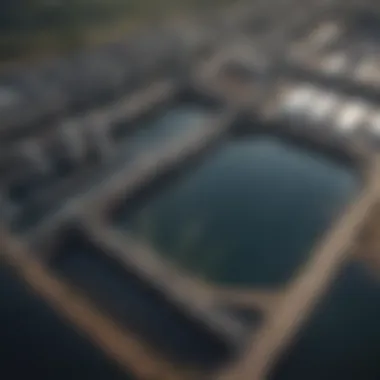Exploring Wastewater Treatment Technologies: A Comprehensive Overview


Intro
Wastewater treatment is a critical component of modern environmental management. With increasing urbanization and industrialization, the proper handling of wastewater has become more pressing. The quest for sustainable practices in this area has led to the development of various treatment technologies. Understanding these technologies is essential for effective water resource management. This section provides foundational knowledge about the concepts and terminology used throughout this article.
Key Concepts and Terminology
Definition of Key Terms
- Wastewater: This term refers to water that has been affected by human use. It includes household sewage, industrial discharges, and runoff.
- Treatment Technology: These are methods designed to remove contaminants from wastewater. This can include physical, chemical, and biological processes.
- Effluent: Treated water that is discharged from a treatment facility, ideally meeting quality standards.
- Sludge: This is the solid or semi-solid residue that remains after wastewater treatment. It often contains a mix of organic and inorganic materials.
Concepts Explored in the Article
This article discusses both traditional and emerging wastewater treatment technologies. Traditional methods include activated sludge processes and trickling filter systems. Emerging technologies might comprise advanced oxidation processes and membrane bioreactors.
The principle behind these methods often focuses on breaking down organic matter and removing harmful pollutants. Understanding the context of application—whether in industrial, municipal, or agricultural areas—helps in selecting the right treatment technology.
Findings and Discussion
Main Findings
- Diversity of Technologies: The analysis reveals a wide range of technologies available. Each comes with specific advantages and limitations. For example, activated sludge systems are widely used due to their efficiency, but they require significant energy input.
- Emerging Trends: Innovative technologies, such as membrane bioreactors, show promise in achieving high-quality effluent. These systems make it possible to recover resources from wastewater.
- Regulatory Considerations: Regulations vary widely based on location and the source of wastewater. Compliance remains a key concern for all treatment facilities.
Potential Areas for Future Research
Further investigation into the following areas may enhance wastewater treatment:
- Energy Efficiency: Research on reducing energy consumption in conventional systems.
- Resource Recovery: Exploring methods to turn waste into usable resources, like biogas or fertilizers.
- Integration of Technologies: Investigating hybrid systems that combine multiple treatment methods for optimal performance.
"As water scarcity becomes increasingly prevalent, the need for advanced treatment technologies gains importance."
Prelude to Wastewater Treatment
Wastewater treatment is a critical process that ensures the safe disposal and management of water that has been used. Effective treatment methods play a crucial role in protecting public health and the environment. This section explores essential elements of wastewater treatment that will be important throughout this article. By understanding these basics, readers can appreciate the complexity of the technologies involved and the reasons behind their implementation.
Defining Wastewater
Wastewater includes water that has been adversely affected by human use. This can originate from households, industries, and agricultural practices. It encompasses a wide range of contaminants, including organic materials, chemicals, and microorganisms. The classification of wastewater can include:
- Municipal Wastewater: Generated by residential and commercial sources.
- Industrial Wastewater: Resulting from manufacturing processes.
- Agricultural Runoff: From farms leading to nutrient enrichment in waterways.
The definition of wastewater is critical for determining the appropriate treatment methods. Each category contains specific contaminants requiring tailored approaches.
Importance of Wastewater Treatment
The significance of wastewater treatment can be understood through several lenses:
- Public Health: Properly treated waste prevents diseases spread by pathogens found in contaminated water.
- Environmental Protection: Treatment processes help reduce pollution levels, safeguarding ecosystems.
- Resource Recovery: Many technologies allow for the recycling of water, promoting sustainability.
The neglect of effective treatment can lead to severe consequences. Unmanaged wastewater can infiltrate water bodies, impairing quality and harming aquatic life.
Overview of Treatment Processes
Wastewater treatment consists of multiple processes designed to remove contaminants effectively. Broadly, these treatments can be categorized into three main phases:
- Preliminary Treatment: Involves screening and sedimentation to remove large solids from the water.
- Primary Treatment: Focuses on settling and separating solids and liquids, often resulting in primary sludge.
- Secondary Treatment: Utilizes biological processes to degrade organic matter further and reduce nutrient levels. Advanced methods may include membrane technologies and advanced oxidation.
Each stage plays a vital role in meeting effluent standards and ensuring water safety. The choice of technologies and processes typically depends on the characteristics of the wastewater being treated, as well as the required water quality outcomes.
"Understanding wastewater and its treatment is essential for effective water resource management. Each phase of treatment impacts both human health and environmental integrity."
In summary, wastewater treatment serves a crucial function in maintaining public health, protecting ecosystems, and facilitating resource recovery. This introduction sets the stage for a deeper dive into specific technologies and methods discussed in this article.
Classification of Wastewater Treatment Technologies
The classification of wastewater treatment technologies is crucial to understanding how we can address the varying challenges of water pollution. Each method may have its own suitability based on the type of waste being dealt with, economic resources, and specific environmental regulations. This classification allows for precise selection that optimizes efficiency while maintaining safety standards. Knowing these technologies empowers municipalities, industries, and agricultural setups to apply the best methods for their needs, thereby ensuring effective water resource management.


Physical Treatment Technologies
Screening
Screening is a primary physical treatment step that separates large solid materials from wastewater. Its key characteristic lies in its ability to prevent pump damage and downstream equipment wear. The process involves passing water through mesh or grating to filter out debris. This method is beneficial as it is relatively simple and cost-effective. However, one of its disadvantages is that it does not remove dissolved substances, which may still require further treatment.
Sedimentation
Sedimentation relies on gravity to settle out suspended solids from wastewater. Its key advantage is the effective separation of settleable solids, thus reducing the load on subsequent treatment processes. This method operates through a gravity-driven process where heavier particles fall to the bottom of a tank. While sedimentation is efficient, it may struggle with finer particles, necessitating additional methods to achieve desired water quality. The unique feature of this process is its ability to operate passively, requiring minimal energy.
Filtration
Filtration is the process of removing impurities from wastewater as it passes through a medium that retains particles. This technology enhances overall water quality by targeting smaller particulate matters that screening may miss. It is popular due to its capability to achieve a high level of purity in water treatment. However, filtration systems may demand regular maintenance and incur ongoing operational costs. One unique aspect is the potential variety of filters used, from sand to membrane types, allowing for tailored applications.
Chemical Treatment Technologies
Coagulation and Flocculation
Coagulation and flocculation involve adding chemicals to wastewater to bind small particles into larger clusters for easy removal. This method is vital in achieving a significant reduction in turbidity, making it a common choice in treatment plants. The main characteristic of this approach is its capacity to handle microscopic contaminant particles. However, a major disadvantage is the need for careful chemical handling and the possibility of residual chemicals affecting treated water quality.
Chemical Disinfection
Chemical disinfection aims to eliminate pathogens in wastewater through chemical agents, most commonly chlorine and ozone. This method is crucial for ensuring the safety of treated water, especially for reuse scenarios. The notable advantage is its proven efficacy in killing harmful microorganisms. However, there could also be concerns regarding the formation of byproducts, such as trihalomethanes when chlorine is used. This must be managed to prevent health risks.
Advanced Oxidation Processes
Advanced oxidation processes (AOPs) are cutting-edge techniques designed to degrade organic pollutants using strong oxidants. These processes represent an innovative approach to breaking down substances difficult to treat with conventional methods. They are sought after due to their ability to reduce pollutants to harmless byproducts. The downside may include high operational costs and the need for specialized equipment, which can limit use in smaller operations.
Biological Treatment Technologies
Aerobic Treatment
Aerobic treatment uses microorganisms that thrive in oxygen-rich environments to decompose organic compounds in wastewater. This method is effective because it takes advantage of naturally occurring biological processes. Its key characteristic is the efficient breakdown of organic matter, which can significantly reduce chemical oxygen demand levels. However, it can also present challenges in colder temperatures or when oxygen fluctuations occur.
Anaerobic Treatment
Anaerobic treatment relies on microorganisms that do not require oxygen to decompose organic material. This method is particularly beneficial for high-strength wastewater, such as industrial effluents. A unique advantage is that it can produce biogas as a byproduct, which can be harnessed for energy. However, one downside is the longer retention time required for effective processing, which needs to be factored into operational planning.
Membrane Bioreactors
Membrane bioreactors combine biological treatment and membrane filtration to effectively separate solids from liquids. This technology has gained popularity due to its compact design and efficient treatment capabilities. The main advantage is the high quality of effluent achieved, allowing for potential water reuse. However, the high energy consumption and membrane fouling are significant disadvantages that must be addressed to ensure sustainability of this technology.
Innovative Wastewater Treatment Technologies
Innovative wastewater treatment technologies represent a crucial evolution in the field of water resource management. As traditional methods face limitations related to efficiency and environmental impact, new technologies offer benefits that align with contemporary challenges such as resource scarcity and pollution control. The integration of these innovative approaches is vital in facilitating more sustainable wastewater management practices.
Constructed Wetlands
Constructed wetlands are engineered systems designed to utilize natural processes to treat wastewater. These systems mimic the functions of natural wetlands, leveraging vegetation, soil, and microorganisms for pollutant removal. Through this approach, constructed wetlands offer several advantages:
- Cost-Effectiveness: They often require lower operational costs compared to conventional treatment systems.
- Biodiversity Enhancement: By promoting flora and fauna, they support local ecosystems.
- Retention of Nutrients: They effectively retain nutrients, reducing the risk of nutrient pollution in nearby water bodies.
While effective, constructed wetlands also face challenges. Seasonal variations can impact their efficiency. Furthermore, careful design is necessary to optimize hydraulic performance and pollutant removal rates.
Microbial Fuel Cells
Microbial fuel cells (MFCs) represent an innovative technology that harnesses the metabolic processes of microorganisms to generate electricity while treating wastewater. In this technology, bacteria consume organic matter, releasing electrons that can be captured as electrical energy. Key aspects of MFCs include:
- Dual Functionality: They provide wastewater treatment and energy generation simultaneously.
- Sustainability: As they rely on organic matter as fuel, they offer a sustainable alternative to conventional energy sources.
- Scalability: MFCs can be scaled up or down, allowing application in different contexts, from small communities to larger treatment facilities.
However, the technology is still developing. Research is ongoing to improve efficiency and reduce costs compared to traditional energy sources.
Electrochemical Treatment
Electrochemical treatment employs electrical current for the treatment of wastewater contaminants. This method can effectively remove heavy metals, organics, and pathogens through various electrochemical reactions. Some important features of this technology include:


- High Efficiency: Electrochemical methods can achieve significant contaminant reduction in a shorter period compared to traditional methods.
- Versatility: This approach can be adapted to different wastewater types, making it useful in both municipal and industrial settings.
- Complementarity: It can be used in combination with other treatment processes to enhance overall effectiveness.
Nonetheless, challenges exist, such as the need for skilled operators and the management of byproducts generated during treatment.
Innovative wastewater treatment technologies are reshaping how we approach water resource management, offering solutions that are not only effective but also environmentally sound.
In summary, innovative wastewater treatment technologies are pivotal in addressing modern water management challenges. Through systems like constructed wetlands, microbial fuel cells, and electrochemical treatment, we can achieve cleaner water and generate energy, paving the way for sustainable practices.
Wastewater Treatment in Different Contexts
Wastewater treatment is crucial across various settings due to the diverse nature of waste produced. Each context presents unique challenges and requirements, thus shaping the approaches to treatment. Understanding how to effectively manage wastewater in municipal, industrial, and agricultural environments helps to protect public health and the environment. Moreover, it enables sustainable water resource management, ensuring future generations can access clean water.
Municipal Wastewater Treatment
Municipal wastewater treatment focuses on urban centers where residential and commercial activities generate significant amounts of wastewater. The primary goal here is to protect public health and the environment by eliminating pollutants before the treated water is discharged back into water bodies.
The treatment process usually involves several stages:
- Preliminary Treatment aims to remove large debris through screening, preventing damage to equipment.
- Secondary Treatment employs biological processes to degrade organic matter. This is often achieved through methods such as activated sludge systems.
- Tertiary Treatment provides advanced purification to remove nutrients like nitrogen and phosphorus, which can cause environmental issues if released in excess.
Municipal treatment plants handle significant flows, necessitating stringent regulations to ensure safety. Effective management in this context results in improved water quality and reduces the risk of pollution in nearby ecosystems.
Industrial Wastewater Management
In industries, wastewater management is often complex due to the various contaminants present in the effluent. Different sectors such as textiles, pharmaceuticals, and food processing generate diverse waste streams that require tailored treatment solutions.
Common methods of industrial wastewater treatment include:
- Pre-treatment, which can involve physical or chemical processes to reduce toxicity.
- Biological Treatment, where microorganisms break down organic material, is frequently used but must be customized to the wastewater characteristics.
- Advanced Treatment Technologies, such as membrane filtration or reverse osmosis, are employed for stringent discharge standards.
Industries face not only operational challenges but also regulatory pressures. Compliance with environmental regulations is essential to avoid fines and damage to reputation. Thus, investing in innovative treatment technologies can lead to both environmental and economic benefits.
Agricultural Wastewater Treatment
Agricultural activities contribute to wastewater through runoff and nutrient leaching. This wastewater often contains fertilizers, pesticides, and organic waste. Proper treatment is vital to mitigate the impacts on local water bodies.
Key practices in agricultural wastewater treatment include:
- Constructed Wetlands, which utilize natural processes to treat water by mimicking wetland ecosystems. They can effectively remove nutrients and pathogens.
- Aerobic and Anaerobic Treatment, both help manage organic loading and can produce biogas as a beneficial by-product.
- Nutrient Recovery Systems that capture and reuse fertilizers from waste streams, promoting sustainability.
By implementing proper treatment methods, agriculture can reduce its environmental footprint, enhance sustainability, and even create additional resources from waste.
"Proper wastewater management in agriculture can lead to significant improvements in water quality and ecosystem health."
In summary, addressing wastewater treatment in different contexts is essential for sustainable management. This ensures that water quality is upheld while considering public health and environmental protection. Each context has its specific elements, mechanisms, and challenges, but all share a common goal—creating a cleaner, healthier planet.
Regulatory and Environmental Considerations
The regulatory and environmental considerations surrounding wastewater treatment are vital to ensure public health and environmental sustainability. They create a framework for establishing standards, protecting water bodies, and promoting sustainable practices in wastewater management. Regulatory measures help mitigate the negative effects of treated and untreated wastewater on both human communities and ecosystems, calling for a structured approach to treatment processes and disposal methods.
Wastewater Treatment Standards
Wastewater treatment standards are essential regulations set forth by governmental bodies to ensure the quality of treated effluent. These standards often dictate permissible levels of contaminants in wastewater, and they vary based on the source of wastewater and its intended use after treatment.
Key standards include:
- BOD (Biochemical Oxygen Demand): Measures organic matter in water, indicating the level of contamination.
- TSS (Total Suspended Solids): Indicates clarity of water; high levels affect aquatic life.
- Nutrient Levels: Regulations on nitrogen and phosphorus to avoid eutrophication in water bodies.
By adhering to these standards, facilities can minimize the risks associated with discharge, ensuring safer water returning to natural systems. Complying with regulations helps facilities avoid legal repercussions while actively contributing to environmental protection.
Impact on Water Bodies
The impact of wastewater discharge on water bodies can be profound. If not treated correctly, effluent can contribute to pollution, harming aquatic ecosystems and degrading water quality. This may lead to a loss of biodiversity, algal blooms, and the alteration of natural habitats.
Effects of untreated wastewater include:


- Toxicity to aquatic life: Harmful chemicals and pathogens can kill fish and other organisms.
- Eutrophication: Nutrient overload from agricultural runoff creates dead zones where aquatic life cannot thrive.
- Contamination of drinking water sources: Pollutants can seep into groundwater or surface water used for drinking.
Technological advancements in treatment processes and stricter regulations are necessary to mitigate these impacts. Monitoring water quality is crucial to understanding the long-term effects on ecosystems and taking corrective action when necessary.
Sustainable Practices in Wastewater Management
Sustainable practices in wastewater management focus on balancing ecological health and resource recovery. The aim is to create a closed-loop system where treated water can be reused, thereby conserving natural resources and reducing overall environmental impact.
Sustainable approaches include:
- Water Recycling: Treated wastewater can be reused for irrigation or industrial processes, reducing fresh water demand.
- Energy Recovery: This involves harnessing energy from the treatment processes, such as biogas generation from anaerobic digestion.
- Green Infrastructure: Utilizing natural systems, such as constructed wetlands, to treat wastewater effectively while enhancing local ecosystems.
Adopting these practices is essential not just for compliance with regulations but also for the overall health of the environment. By prioritizing sustainable options, stakeholders contribute to a healthier planet and a more resilient water resource management system.
The link between strong regulatory frameworks and healthy ecosystems cannot be overstated. Effective regulations are the backbone of sustainable wastewater management.
Future Trends in Wastewater Treatment
The topic of future trends in wastewater treatment is crucial within the broader scope of this article. As urbanization grows and environmental concerns mount, the demand for innovative solutions in wastewater treatment becomes more pressing. These advancements not only address current inefficiencies but also prepare for a future where the sustainability of water resources is paramount.
Several specific elements are noteworthy in this context: emerging technologies, the integration of smart solutions, and the evolving challenges and opportunities within the sector. All of these will play vital roles in shaping the strategies employed for managing wastewater effectively.
Emerging Technologies
Emerging technologies represent a significant pivot in wastewater treatment approaches. They address shortcomings of traditional approaches and leverage new scientific advancements. For instance, technologies such as membrane bioreactors and advanced oxidation processes are gaining traction due to their ability to effectively treat contaminants that are often resistant to conventional methods.
Another notable technology is the use of constructed wetlands for natural treatment processes. These systems use vegetation, soil, and microbial communities to filter pollutants from wastewater, thus achieving biological treatment in a more eco-friendly manner.
Additional technologies worth monitoring include:
- Microbial Fuel Cells: These devices convert wastewater’s chemical energy into electricity, thus offering a dual benefit of treatment and energy generation.
- Electrochemical Treatment: Utilizing electrical currents to remove contaminants demonstrates a significant advancement in processing efficiency.
Integration of Smart Technologies
The integration of smart technologies is revolutionizing wastewater management. The application of the Internet of Things (IoT) allows for real-time monitoring of wastewater facilities. Sensors can track water quality, flow rates, and operational efficiency. This increased visibility enables prompt responses to issues, minimizing adverse effects on the environment.
Data analytics plays a pivotal role here, interpreting extensive data sets for optimizing operations and planning maintenance. Furthermore, predictive models could foresee equipment failures or treatment failures, thus enhancing the overall reliability of treatment facilities.
This technological shift not only improves operational capabilities but also fosters transparency and accountability, which is increasingly vital in today’s water management landscape.
Challenges and Opportunities
While many promising trends are emerging, the sector also faces significant challenges. Regulatory frameworks must adapt to accommodate new technologies and processes. Moreover, the financial implications of adopting cutting-edge technologies can be daunting for some municipalities and organizations.
However, these challenges concurrently present opportunities. Collaboration between public and private sectors can fuel the research and development of innovative solutions. Shifting public perspectives toward sustainability can lead to increased funding and support for modernizing wastewater treatment infrastructure.
Societal demand for sustainable practices reinforces the role of wastewater treatment as a vital component of environmental stewardship. Thus, a proactive approach toward embracing these future trends can yield substantial benefits for both water resource management and broader ecological integrity.
"Innovation in wastewater treatment technologies is not merely beneficial; it is essential for ecological balance and public health in our rapidly changing world."
Ultimately, the future of wastewater treatment hinges on a combination of emerging technologies, smart integration, and an agile response to the inherent challenges and opportunities that lie ahead.
Finale
In this final section, we reflect on the significance of wastewater treatment technologies presented in this article. Understanding these technologies is vital not only for enhancing public health but also for preserving the environment. Each method offers unique approaches to managing wastewater, which ultimately helps in recycling water and maintaining a sustainable ecosystem.
Efficient wastewater treatment reduces pollution and mitigates the risk of waterborne diseases. Furthermore, advances in treatment technologies can lead to the recovery of resources, such as energy and nutrients, from waste.
Summary of Key Points
- Various treatment technologies are available, including physical, chemical, and biological methods.
- The article covers traditional and innovative solutions like constructed wetlands and microbial fuel cells.
- Importance of regulatory frameworks to ensure compliance with water quality standards.
- Future trends point towards smart technology integration and the rise of decentralized systems.
"The journey of wastewater treatment is intertwined with the future of sustainable water resource management."
Considering these aspects, it is clear that ongoing research will refine these technologies. Understanding local contexts and needs can significantly improve outcomes in wastewater treatment.
Future Directions for Research
Research must continue to evolve to meet the emerging challenges in wastewater treatment. Specific focus areas should include:
- Advanced Treatment Methods: Studying and developing more efficient ways to reduce contaminants.
- Resource Recovery: Exploring techniques to reclaim energy and materials during the treatment process.
- Smart Systems: Leveraging IoT and AI technologies for enhanced monitoring and management of wastewater facilities.
Continued collaboration between research institutions, government bodies, and industries is essential. This collaboration could significantly drive innovation and yield practical solutions to the global water crisis. By investing in research and development, we can ensure that wastewater treatment is not only effective but also sustainable.







